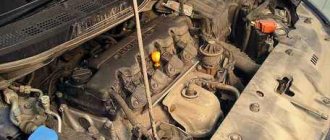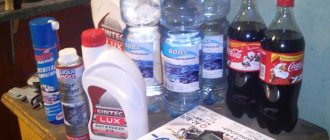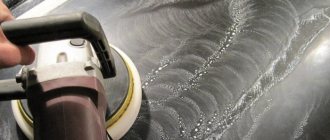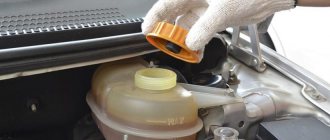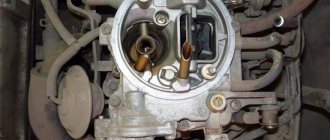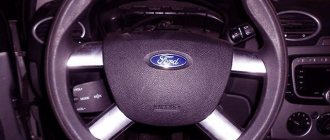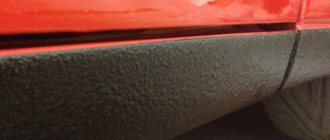Every driver, looking under the hood, often sees the power unit covered in dirt and oil. Then the car owner has a question: how to wash the engine yourself? Another interesting article: how to wash a car correctly.
Before you start washing, you need to thoroughly inspect the engine compartment for the presence of electronics and other electrical modules. If you have a new foreign car, most likely there will be a lot of sensors, relays, and so on on the engine, it is better to wash such a car in a car wash because if you fill all the electronics of the car with water, then it may not start until the water dries, and even worse you can burn something.
Although car washes are also different, many will not give you any guarantees, so the choice is up to the car owner. Repairs in this case can be very expensive.
Pros of engine washing
If you still have an older car, the engine is clearly visible from all sides, and there are almost no electrical units, then you can try to wash the engine yourself.
A clean engine is not only beautiful, but also very useful. A dirty engine overheats much faster than a clean one. If there is dirt near the hole into which the dipstick is inserted to check the oil, there is a high probability of abrasive particles getting into the engine crankcase when checking the oil level.
It is also bad if the electrical wiring is dirty, there may be current leakage through it, which will lead to deterioration in engine performance. Even if moisture gets on such electrical wiring, it will already become electrically conductive. From this we conclude that it is necessary to wash the engine not only for aesthetic reasons.
How and with what to wash the engine yourself?
Before washing your car, it is recommended to remove the battery from the car and cover all electrical appliances with plastic bags to prevent water and cleaning agents from getting into them.
What product will we use to wash our engine? It is better, of course, to buy a special solution for washing power units. But you can also use improvised means, which are much cheaper and much easier to find.
1. You can choose regular diesel fuel; it will cope well with oil and dirt on the engine, but there are many disadvantages when using it. It leaves behind a greasy coating on the engine, to which all the dust will again stick. Plus, diesel fuel is also a fire hazard.
2. A solution of ordinary washing soap diluted in warm water will be more favorable and safe. Once we have decided on the cleaning solution, we can start washing the engine.
First we need to start it and warm it up to a temperature of 40 degrees, but no more! This is done to improve the release of oil stains on the engine. As soon as the engine has warmed up, apply a solution of soap and warm water to the contaminated surfaces with a regular rag and wait for 10-15 minutes until the dirt dissolves.
Now take a wooden or plastic scraper and remove dirt from the engine in flat areas. When the main layer of dirt is removed, take a brush for shoes or clothes, it makes no difference, as long as it is hard and remove the remaining dirt. In hard-to-reach places, you can use a toothbrush.
After only small stains of oil and dirt remain on the engine, take a rag soaked in a soap solution and wipe the whole thing off.
After washing, you need to take a compressor, or, in extreme cases, a vacuum cleaner, and thoroughly blow off every part of the power unit so that there is no moisture left anywhere.
The engine does not need to be pressure washed. After such a wash, water enters the distributor, air cleaner, spark plug wells and other electronic control units. Also, water gets into the wire connectors and does not dry out for a long time, several days, and provokes corrosion.
The battery must be replaced and connected only after the engine has completely dried out. Don't forget that a clean engine is easier to keep in good condition. So wash it more often, especially after winter, because in the cold season the power unit gets exposed to more aggressive substances that cause corrosion.
2 What products are needed to wash the engine yourself?
Regular household cleaning products are not suitable for washing the engine and engine compartment, although some drivers use them. The reason is that kitchen cleaners are designed to remove plant compounds. The chemical composition included in household chemicals can have a harmful effect on rubber parts and engine gaskets. They can dry out or harden, thus losing their performance properties.
If you choose the right cleaning products, you can achieve good results. The automotive market has a wide selection of chemicals in the form of liquids and aerosols. The most common liquids are shampoos. They are good for cleaning hard-to-reach places. Due to their liquid state, they penetrate into the furthest parts of the engine, washing away stubborn dirt. Shampoos do not contain abrasive particles, so they do not scratch the surface of parts, but they can be used to polish.
The choice of engine cleaning products is truly great - everyone chooses what is more convenient for him to use
To wash engines, you should not use car shampoos for washing the outside of the car, but white spirit.
Aerosols are convenient to use for modern cars that have tight spaces under the hood. They can be applied to hard-to-reach places without disassembling the engine. In stores you can find special powder for washing the engine. It is used if dirt and dust are strongly embedded in the metal surface. Powders contain caustic chemicals, so you need to wear rubber gloves when handling them to protect your skin. Cleaning should be done in a well-ventilated area, preferably outside.
It is better to buy special chemicals from well-known brands to clean your car from oil and other contaminants:
- “Motorraum-reiniger” from Liqui Moly;
- TurtleWax “High Tech Engine Clean”;
- car shampoo for engines from AT VNII Khimproekt;
- “Cleansing agent for engines and units” from AutoStudio.
There are concentrated liquids that are inconvenient to use because they need to be diluted, but with their help you can wash off heavy stains the first time.
We recommend: Automatic transmission, CVT and robot: pros, cons, differences
The need to periodically wash the engine
Dirt and excess oil on the outer surface of the engine make it difficult to visually locate lubricant or coolant leaks. Also, too large a layer of deposits can disrupt the temperature regime of the engine, which will lead to excessive fuel consumption, and subsequently to increased wear of rubbing parts. Dirt under the hood tends to get not only onto the engine, but also onto the elements of the car's electrical network, which causes a short circuit. If oil leaks are not removed promptly, vapors are formed that are highly flammable and can lead to a serious fire.
Preparing to wash a car engine
- Before washing the engine, you need to close all sensors, relays and other devices for which you do not want water to enter. Aluminum foil is perfect for this. It masks the engine elements and stays in place well. The foil takes the shape of the parts wrapped in it and does not interfere when cleaning the engine.
- You need to spray regular clean water on the parts around the engine compartment. This will make it easier to wash off engine cleaner from adjacent parts that may get on them when washing the engine compartment and engine. If this is not done, the dried product will leave marks that are not easy to wash off.
- Do not wash a hot engine. It is better to plan a wash after the engine has completely cooled down. To loosen oil and dirt accumulated on the engine and its components, it is best to warm up the engine for a few minutes until it is warm. The best temperature for washing the engine is such that the engine is warm to the touch.
How to wash a car engine yourself
If the question arises about how to wash a car engine at home, then there will be several options. The motorist can use a pressure washer or car engine cleaner. Steam cleaning has also gained popularity recently. It is necessary to dwell in more detail on each of the methods.
Cleaning a Karcher washer at home
If you have the necessary equipment, you can wash your car engine with a Karcher. This method allows you to thoroughly clean the engine of dirt and oil. But it is worth remembering that high-pressure washers can damage the insulation and knock off the stickers on parts. It is also possible for water to enter the connectors, causing electrical equipment failure. Therefore, you need to make sure that the pressure is not too high.
How to properly and safely clean an engine with detergent
There is another option on how to effectively and properly wash a car engine. In this case, you don’t even need any equipment. It is enough to take water and purchase a special liquid for washing the engine. The procedure will be as follows.
- First you need to wait until the engine cools down (if this is not done, the cylinder head may become deformed). Next, all preparatory work is carried out.
- The product is applied according to the instructions that come with the liquid.
- Problem areas are additionally cleaned with a brush.
- After the period of time specified in the instructions, the product is washed off.
- The protective film is removed.
- The engine is drying out. If possible, you can use compressed air. Otherwise, just letting the car sit for a while is enough.
- The engine is started to check if washing the engine yourself has caused any harm.
WATCH THE VIDEO
Steam washing
This option combines the advantages of the other two methods. In this case, the motor is not harmed due to pressure, but at the same time, the effectiveness of the procedure remains high. Equipment for such cleaning is available at car washes (although it will cost more than using a high-pressure washer).
WATCH THE VIDEO
What to use
It is interesting that at many self-service car washes it is prohibited to touch the engine compartment. That’s why it’s not always possible to wash your car here.
Regular car washes offer cleaning services for neglected and dirty engine compartments. The only problem is that basically they simply supply regular water or water mixed with shampoo to the engine under high pressure. By knocking down dirt, at the same time, the integrity of the wiring is often compromised; water penetrates where it should not be.
Even the issue of using a homemade high-pressure washer has certain complaints, if we talk specifically about cleaning the engine compartment.
Therefore, it is logical to ask what exactly can and should be used. Let's consider several options:
- Bucket of water and brush
. Relatively safe, but ineffective. This method will be very difficult to clean the motor if it is really dirty; - Water and high pressure
. This is a risk of causing mechanical damage to wiring, gaskets, etc. It gives a quick effect and good results. But it's better not to take risks; - Diesel, gasoline and kerosene
. They serve as solvents for dirt. You should absolutely refuse gasoline. It is the most flammable. Kerosene and diesel are less dangerous, but when processing heating engine elements they can cause smoke; - Steam
. But steam washing is quite effective and relatively safe. We have already talked about it separately; - Special means
. Shampoos and car chemicals are available for sale, the task of which is precisely to clean the engine compartment. Many of them are really effective; - Household chemicals
. It is often used as a homemade product for cleaning internal combustion engines at home. When used correctly it gives excellent results.
Even if the block is entirely aluminum, rust is not the only major problem if the compartment is not washed properly.
Yes, the easiest way to bring it to perfect condition is with a removed engine. But no one will resort to such things for the sake of washing.
Preparing the engine for washing
It is best to do this if there is any breakdown. Then the engine is removed from the car, all attachments are removed and the patient is ready for the procedure. However, it gets dirty much more often than it breaks, so everything will have to be done on the spot. This is the whole problem. In addition to a metal block that is invulnerable to water, under the hood there are various sensors and electronic systems, of which there are more than bolts in a modern car. If even a drop of moisture gets on them, you can take the car to a car service center, since something will definitely not work. To prevent this from happening, you need to follow some recommendations and be as careful as possible in this matter.
- Logically, you need to first protect the electronic part, which can be done with ordinary wide tape. We disconnect and remove the battery, and then wrap the terminals. Carefully inspect all sensors and wire connections that are located outside, and try to insulate them as best as possible. You won't be able to provide guaranteed protection, but it doesn't hurt to be insured. Pay special attention to the ignition and generator so as not to fill them with water.
Insulating parts from water
- After the electronic part, you can deal with the protection of the engine compartment, which is bolted to the car body at the bottom. Removing it gives you access to the front of the engine.
Removing the engine compartment protection
- The next step will be to protect the contacts and connectors. This can be done using special compounds sold in aerosol cans. They have a water-repellent property, which will preserve connections made of non-ferrous metals from corrosion.
Special product for protecting electrical contacts
- The most extensive part of the work remains - dismantling the attachments. Here, the more you can remove, the more convenient it will be to wash. Ideally, there should be only one block with a head left. Then you will be able to get into almost all places and make the engine as clean as possible. At this point, the main thing is not to unscrew the spark plugs, since water should not get inside the cylinder.
It is recommended to remove all attachments from the vehicle
When removing equipment, pay close attention to how it was positioned. It is better to put everything dismantled in one place so as not to lose it. The important part is also disconnecting the wiring. Here, too, you need to monitor how all the chips are connected, since in the future it will take a lot of time to find the right connector.
After washing the engine the car does not start, what should I do?
Often after washing the engine it does not start and this is common. The main reason is moisture entering the electronics system, which does not allow the engine to start, but at this very moment the starter is spinning and there are attempts to seize, but the unit cannot start. Moisture gets in due to the main mistake - washing under high pressure reaches 100-150 bar, due to which the water flow can penetrate anywhere, even into the spark plugs.
The biggest problem after washing the engine is with the ignition system. To solve it, you need to disassemble the distributor and wipe everything dry, then blow it with a compressor, wipe the wires, dry the wells for installing spark plugs with a compressor, and then you can start the car.
In models where individual ignition coils are installed instead of a distributor, you need to remove each one separately and blow out the wells; it is also worth blowing out the entire engine and engine space with a compressor and additionally leaving it to dry for 3-4 hours with the hood open. By the way, it is better to carry out all of the above actions before the first start of the engine after washing, otherwise, if moisture is found where it is now described, you can get several non-working coils. Often the coils remain unharmed, but the spark plugs themselves fail and only need to be replaced with new ones.
We recommend: Sequential gearbox: what it is and how it works
Engine washing methods
When the question of how to wash a car engine has been decided, let’s decide how to do it. And here are some common methods :
- Dry cleaning . Use liquid or foam in an aerosol can. There is no need to rinse with water after applying the substance. Before using such a product, it is necessary to warm up the engine , but not to a too hot state. If you apply the product to a cold engine, cleaning will not be effective. It is prohibited to apply to some parts of the internal combustion engine; this is indicated in the instructions. The process itself is also very labor-intensive.
- Steam washing . This professional method is not suitable for home use. Only a specialist knows how to properly wash and not damage the engine.
- Karcher . Not the safest method of contactless cleaning. High pressure water can damage some parts of the internal combustion engine. A small amount of liquid can also get inside the motor and cause damage or corrosion.
- Rinse with water . A special cleaning agent is first applied. After some time, it is simply washed off with a stream of water. This method is the most common, but does not protect against moisture getting into the motor.
The engine compartment needs to be flushed only once a year.
Why do you need to wash the engine and engine compartment?
You need to wash your car's engine compartment once or twice a year. At the same time, answering the question of why to do this, it is worth giving the following arguments:
- a clean engine does not heat up, since dust acts as a body insulator and creates additional load on the car’s cooling system. If you wash it off, the motor will run smoothly, without interruption.
- If the engine compartment is clean, it is easier to maintain.
- In a dirty engine compartment, fires may arise from leaks of gasoline and automobile oil. For this, a simple spark or a breakthrough of exhaust gases is enough.
- Washing the engine is also necessary because it allows you to independently detect a leak on the clean surface of the power unit. As a result, it becomes possible to take timely measures without waiting for the situation to worsen.
- Before selling, the engine must also be washed in order to show the potential buyer that it works without interruption. In addition, a clean engine compartment allows him to adequately assess the technical condition of the engine.
What to wash with?
Laziness and technical illiteracy lead to standard mistakes, repeated time after time by those who wash the engine for the first time.
Using kitchen detergents
is used often, and with the same frequency leaves the car owner dissatisfied. Even the highest quality dishwashing gel cannot cope with stubborn used oil. And the use of harsher agents, such as those intended for washing away carbon deposits on a stove, can lead to corrosion of individual elements of the mechanism.
Washing the engine with gasoline, kerosene or diesel fuel is a direct path to a possible fire at the first start. Their vapors linger for a long time in the engine compartment and easily flare up. Diesel fuel is a little less safe, it has less volatility. However, the engine treated with it will smoke terribly, and smoke will begin to pour out of all the cracks. And the risk of fire remains high.
It’s safer and more painless to go to an auto chemical store. Special equipment is quite affordable, and anyone can afford to buy it twice a year. In addition, they are mainly produced in the form of sprays, which makes cleaning much easier.
How and with what to properly wash the engine?
To properly wash the engine, you should not use ordinary water, but only under high pressure. If you wash the motor in this way, you can harm the insulation and provoke the rust process not only on external metal parts, but also inside the connectors of the electrical circuit. Rather than resorting to improvised means to wash a car engine of oil, it is best to use special car shampoos or foam cleaners that effectively remove oil deposits. You should not dilute ordinary laundry soap in water and try to wash off all the dirt with a similar solution. Household products will not help to properly clean the engine surface, but will only lead to a loss of time.
Apply cleaning agent
After the engine has warmed up a little and some elements have been protected from moisture, you can begin spraying the engine cleaner. Modern engine cleaning products act quickly and effectively. If the engine is not very dirty, then it is not advisable to use too aggressive products based on petroleum products or solvents. They quickly act on oil contaminants and stubborn dirt, but at the same time they destroy rubber tubes and plastic in the engine compartment. It is better to use water-based cleaners.
General purpose cleaners that can remove grease can be used.
Depending on how dirty the engine is, you need to let the cleaning agent soak into the dirt film for 3–10 minutes. Do not allow the cleaner to dry on the engine after spraying. This will leave traces of the product.
If the engine is not very dirty, then you can do without using a brush. In case of heavy contamination and stubborn dirt, it is better to use a brush with a long handle. For some hard-to-reach places, you can use a toothbrush.
After applying engine cleaner and, if necessary, using a brush, thoroughly rinse the engine and its components with water.
We recommend: How to check the spark on an injection engine
If you use a pressure washer, do not apply too much pressure or spray water too close to electrical connectors to avoid damaging them.
Allow the water to dry briefly, then wipe accessible engine parts and plastic parts with a clean rag before the water dries itself to avoid leaving any traces of dried water. After wiping with a dry cloth, start the engine and let it run for a few minutes. This will help the remaining moisture evaporate.
Once everything is dry and the engine has cooled, it would be a good idea to apply a special protective coating for the engine. You can also apply a protective coating to the engine compartment plastic and rubber tubes.
Choosing a product: what is the best way to wash the engine?
A car engine cleaner is selected taking into account design features. On most older car models, the engine compartment has a lot of free space. Bottles with a hand sprayer are suitable here. If there is little space, then it is better to choose an aerosol.
In any case, mixtures cannot be used to clean the body. They have too much acid content and can adversely affect the condition of the parts. It is strictly prohibited to use gasoline or diesel fuel, as they are highly flammable. And dishwashing liquids are ineffective.
WATCH THE VIDEO
Engine cleaner can be found at a specialty store. The choice of substances is very large, so any car owner will be able to find a suitable option. Popular cleaners are: Autosol Schmutz (400 rubles for 500 ml), TurtleWax (300 rubles for 500 ml), and GUNK CL32 (550 rubles for 928 ml).
Some motorists prefer to make their own engine cleaner. There are many recipes for such mixtures and they all help wash oil off the engine with varying effectiveness. The simplest and most effective option is washing powder dissolved in warm water.
How to wash?
First of all, competent preparation, consisting of the following actions:
- The minus is removed from the battery;
- The generator, all connectors and wiring joints are wrapped with electrical tape or tape;
- The thickest layers are cleaned off with a spatula or screwdriver;
- The cleaner is applied (through a spray or brush) to all dirty surfaces and left to act;
- The time for this is indicated on the bottle, it ranges from 10-20 minutes;
- The product with softened contaminants is washed off. It is better to do this with a stream of water, and quite hot, otherwise you will have to deal with oil stains for a long time. Pass over all surfaces with a brush; If dirt that has not been washed off is detected, the rinsing is repeated. Once the DIY car engine cleaner is removed, the engine is dried either by drying or naturally by opening the hood and leaving the car in the sun.
Source
How to wash a car engine
After preparation, you can start washing. But for this you still need to choose the right tool. It should not harm the material from which the block and other parts are made, and also remove all oil deposits without any problems. Such substances are sold in any car store and are not very expensive, that is, there will be no problems with selection and purchase.
Engine cleaning products are many and varied.
Therefore, it’s easier to say what not to wash the engine, what products can harm it and what not. To find out, you also need to consider what material it is made of. Most often, the engine block is made of cast iron or aluminum alloy, therefore, it cannot be exposed to acid , which is found in large quantities in various products. You also need to be careful with plastic parts so as not to spoil them.
are NOT RECOMMENDED for washing the engine , as they are ineffective or dangerous:
- Dishwashing liquid. The worst and most hopeless option, since it cannot cope with machine oil.
- Gasoline, kerosene, diesel fuel and other flammable substances. Many people use them for cleaning due to the fact that they are powerful solvents. Once in the oil, it acquires the consistency of water, which means that removing it from the surface of the engine will not be difficult. However, they are all highly flammable, which puts an end to their effectiveness. If after the procedure there is even a drop of such a substance left under the hood, then a fire is guaranteed. In addition, solvents have a negative effect on plastic products.
- Water. A pointless waste of time that will yield no results at all.
An engine detergent should dissolve oil well and not contain acid in its composition, and also be safe and non-flammable. Almost all specialized liquids that are sold in a spare parts store have such properties. That is, in order to wash the engine quickly and without problems, it is best to buy the product.
Why wash the engine?
Let's look at the main reasons why it is worth monitoring the engine compartment and cleaning it in a timely manner.
Firstly, a power unit that is promptly cleaned of dirt, oil and other contaminants will last much longer. The engine requires proper operation of the cooling system, so it is important to monitor and clean it promptly.
Secondly, the accumulation of dirt accelerates the wear of engine parts. Large layers of dirt and oil begin the corrosion process, as a result of which small metal parts of the elements enter the engine oil. Thus, these contaminants circulate throughout the engine system and settle inside. This leads to a significant reduction in engine life, which leads to disruption of its operation and loss of technical characteristics.
Thirdly, in addition to the power unit, there are a large number of electronic systems under the hood. Contamination can disrupt the operation of ignition systems. In addition, large layers of oil can lead to emergencies such as fire. An inadvertent spark or exposure to exhaust gases may cause a fire.
I think that every car owner will agree that when you open the hood, it is much more pleasant to look at a clean engine.
How to wash a car engine at home?
You can wash a car engine at home yourself and this is accessible to everyone; the main thing with this procedure is not to wash the engine under high pressure and strictly follow the instructions. The engine compartment is washed differently, depending on the year of manufacture of the car. It is better to wash foreign cars produced since 2003 manually, using a damp rag or sponge, and it is important that the sponge is almost completely devoid of water. Before 2003, cars were washed both manually and with Karcher mini-washes, which have a nozzle for distributing the flow of water into several dozen weak jets mixed with air. You can wash new foreign cars this way, but be extremely careful.
To wash the engine you will need:
- Rags for initial cleaning of dirt;
- Thick bags for sealing electronics adjacent to the motor;
- Detergent brands: K&W, Liqui Moly, "VNIIkhimproekt" or dishwashing detergent of the "Fary" type for secondary cleaning of complex and medium-sized stains and a bucket of water to dissolve the detergent;
- A brush with plastic bristles for cleaning hard-to-reach places, a sponge for removing excess moisture;
- Dry towels or cloth, but always dry and clean, to remove remaining moisture in visible areas;
- A fan, if available, or a compressor for inflating tires for drying;
- A mini-wash, if available, for a faster cleaning process, replaces a bucket, brush, sponge, etc..
When washing the engine compartment, it is better to use household chemicals only in case of light contamination; for everyone else, you need professional chemicals that are aimed at removing heavy contamination.
Recommended products
The auto chemical market offers a large number of gels, concentrates and shampoos to choose from, with the help of which it is not difficult to wash the engine of contaminants.
Below are some of them:
- LCM. Cleaning agent for power plants and engine compartments in general. Available in the form of a concentrate, which is diluted with water before use. Available for sale in 5 and 20 liter canisters;
- GOLDEN STAR Motorreiniger 5. Concentrate with water-repellent and preservative properties. To wash off the surface, using a water mist is sufficient. Sold in 10 l canisters;
- PLEX BIG STAR engine cleaner. Product for home use. It is a ready-to-use product. Apply to the surface of the motor using a spray gun;
- PLEX BIG STAR. Water-based concentrate for washing the power unit and engine compartment for professional use in car washes. Sold in 10-liter cans;
- Plex® MOTORSHINE. Concentrate for washing engines with low foaming properties. Intended for use in car washes, as it is sold in 10 liter canisters;
- Engine cleaner "Motor". They can be used to wash the engine both at home and in car washes. Sold in containers of 500 ml (with spray), 1 l and 5 l;
- ATAS DMS. Designed for cleaning diesel engines of construction and agricultural equipment. Not recommended for washing plastic and rubber engine parts. Sold in an 8 kg jar;
- DMS-1508 . Spray for cleaning the power unit at home. Sold in 400 ml cans;
- K2 Akra. Very popular among car enthusiasts for home engine washing. Sold in 770 ml containers with a spray bottle;
- HI-GEAR HG-5377 . Foam composition in the form of an aerosol for use in garage conditions. Available for sale in 500 ml cans;
- ABRO DG-300 . Another foam spray for home use. Sold in 510 ml cans.
As you can see, there are a lot of means for washing the engine. Some of them are intended for use in car washes, the second - for self-washing.
Choosing detergents
So how can you wash and clean the engine of your favorite car at home yourself? To clean it, regular soap is not enough. In addition, household detergents are not suitable for these purposes. To effectively remove dirt from the engine, it is better to buy special substances . They can be both universal and specialized:
- Universal. Designed for washing not only the car as a whole, but also for washing the area under the hood.
- Specialized. They can be used both to remove oils and to remove dust and dirt. Designed for both the engine and other parts of the machine.
To wash dirt from the engine, you can use a bottle with a manual sprayer . But it is convenient only when the internal combustion engine and other components do not fit tightly together. Under other conditions, it is better to use an aerosol spray . This way you can process hard-to-reach parts of the internal combustion engine.
Detergents
Any car, like a person, requires care and hygiene. Many car enthusiasts ask the question: “How to clean the engine?” Few people know that washing a power unit is a rather complex process that requires certain knowledge. After all, it is not possible to clean the engine compartment with ordinary water and a brush. To perform this process efficiently, it is necessary to resort to the use of specialized engine cleaning products.
Many car enthusiasts use high-pressure water equipment to perform cleaning. The problem is that a high-pressure jet can cause mechanical damage to electrical equipment, wiring, and gaskets, which can result in engine failure. This method is quick, but there is a high risk of damage to electronic equipment and ignition systems.
In addition to the use of washing installations, the cleaning method with various fuel compositions, for example, kerosene, diesel fuel or gasoline, is also common among car owners. This method has a number of disadvantages. Gasoline is the most unsafe of the above mentioned products. It has a high risk of fire and produces explosive vapors.
Kerosene or diesel fuel, compared to gasoline, is the least safe for cleaning engine walls. They have a low degree of combustion, but create other unpleasant problems. After washing with kerosene or diesel fuel, the heating walls of the engine will begin to evaporate acrid smoke. This method is the least safe, and the evaporating smoke from kerosene will cause discomfort to the owner and passengers of the car.
More experienced car enthusiasts use specialized detergents to clean the engine at home. Each product is individual and has a different composition. This method is the most effective and safe, but even in this case you need to be careful. Chemicals can oxidize metal engine elements, as well as destroy plastic and rubber elements.
We recommend: Proper dilution of antifreeze concentrate
There is a huge variety of detergents designed specifically for external engine washing. There are two main types of chemicals for washing engines:
- Means for removing various types of dirt (universal).
- Means for removing a specific type of contamination, for example, to clean the engine from oil.
Such products are sold in the form of plastic or glass containers, or in the form of aerosols for spraying.
Chemicals are very individual, so it is very difficult to choose the most effective cleaning product. In most cases, a one-time use of such compositions will not bring the desired result, so washing is carried out repeatedly. Before choosing such a product, you need to carefully study its composition and it is better to give preference to more well-known brands.
conclusions
The car engine needs to be washed, just like all its other structural elements. At the same time, when washing it, it is necessary to follow certain rules in order not to damage the power unit and the components of the engine compartment. The frequency of washing the engine is once a month and should be adhered to so that the engine not only looks neat, but is also in good working order. With a clean engine, you can see traces of fuel and oil leaks in advance, and eliminate the faults that caused them in a timely manner.
Why is dirt under the hood dangerous?
The heart of the car is the power unit, and even small pollution affects power and performance.
Violations of thermoregulation lead to overheating of the cylinder walls, changes in heat transfer affect all ongoing processes. Used motor oil accumulated outside the engine significantly affects the growth of contaminants. The presence of an oil layer affects corrosion processes, metal particles destroy the surface of components, dirt settles on attached parts, reducing their service life. Cleaning the motor is required because:
- proper care increases the service life of the engine and ensures the correct operation of the cooling system;
- power unit components wear out more slowly (due to better heat transfer);
- electronic sensors and engine compartment devices are functioning correctly;
- the ignition system remains operational longer.
The reason to start cleaning the engine compartment is also to prepare the car for sale. This is the only way the buyer will appreciate the car at its true worth.
